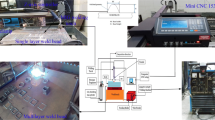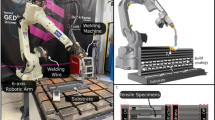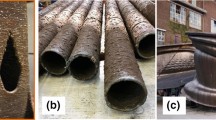Abstract
Wire arc additive manufacturing (WAAM) stands out in manufacturing metallic structures due to its great potential for application in industry for automated production of parts with large dimensions and considerable geometric complexity. Due to the wide presence of ribs and wall crossovers in several mechanical components, this work studied the thermal behavior of the low alloy steel wire AWS ER80S-G in a 10-mm-wide and 90-degree intersection, discovering its influence on the microstructure and hardness of the material compared to a flat wall. Thermal analysis showed that the cooling rate at the intersection is lower than that of a flat wall. However, the evaluation of the cooling curves in a CCT diagram of the steel, later confirmed by a metallographic analysis, indicated that the difference between these two regions was insignificant, as the microstructure was quite similar between them (76% ferrite, 20% pearlite, and 4% retained austenite). On the other hand, there was a significant difference among the layers in the same region, ranging from the morphology of acicular grains at the base and top to equiaxed grains in the intermediate region (ASTM grain size 9). This difference in microstructure was significant for the hardness of the material according to the deposited layer; however, there were few differences between the intersection and the flat wall. Therefore, there are no significant differences between these regions concerning the microstructure or cooling rate, with the variances observed in the hardness being more significant only among the layers deposited.


















Similar content being viewed by others
Data Availability
Data sets generated during the current study are available from the corresponding author on reasonable request.
References
Scharf-Wildenhain R, Haelsig A, Hensel J, Wandtke K, Schroepfer D, Kannengiesser T (2023) Heat control and design-related effects on the properties and welding stresses in WAAM components of high-strength structural steels. Weld World 67:955–965. https://doi.org/10.1007/s40194-022-01450-x
Taşdemir A, Nohut S (2020) An overview of wire arc additive manufacturing (WAAM) in shipbuilding industry. Ships Offshore Struct 16(7):797–814. https://doi.org/10.1080/17445302.2020.1786232
Tamir TS, Xiong G, Shen Z, Leng J, Fang Q, Yang Y, Jiang J, Lodhi E, Wang F (2023) 3D printing in materials manufacturing industry: a realm of industry 4.0. Heliyon 9(9):E19689. https://doi.org/10.1016/j.heliyon.2023.e19689
Mu H, He F, Yuan L, Commins P, Wang H, Pan Z (2023) Toward a smart wire arc additive manufacturing system: a review on current developments and a framework of digital twin. J Manuf Syst 67:174–189. https://doi.org/10.1016/j.jmsy.2023.01.012
IvánTabernero PA, Álvarez P, Suárez A (2018) Study on arc welding processes for high deposition rate additive manufacturing. Proc CIRP 68:358–362. https://doi.org/10.1016/j.procir.2017.12.095
Rodrigues T, Duarte V, Miranda RM, Santos TG, Oliveira JP (2019) Current status and perspectives on wire and arc additive manufacturing (WAAM). Materials 12:1121. https://doi.org/10.3390/ma12071121
Kozamernik N, Bracun D, Klobcar D (2020) WAAM system with interpass temperature control and forced cooling for near-net-shape printing of small metal components. Int J Adv Manuf Technol 110:1955–1968. https://doi.org/10.1007/s00170-020-05958-8
Pan Z, Ding D, Wu B, Cuiuri D, Li H, Norrish J (2018) Arc welding processes for additive manufacturing: a review. In: Chen S, Zhang Y, Feng Z. Transactions Intell Weld Manuf 3–24. https://doi.org/10.1007/978-981-10-5355-9_1
Knezović N, Topić A (2019) Wire and arc additive manufacturing (WAAM) – a new advance in manufacturing. In: Karabegović I (ed) New Technologies, Development and Application. NT 2018. Lecture Notes in Networks and Systems, vol 4. Springer, Cham. https://doi.org/10.1007/978-3-319-90893-9_7
Dhinakaran V, Ajith J, Fahmidha AFY, Jagadeesha T, Sathish T, Stalin B (2019) Wire arc additive manufacturing (WAAM) process of nickel-based superalloys – a review. Mater Today: Proc 21:920–925. https://doi.org/10.1016/j.matpr.2019.08.159
Lin Z, Song K, Yu X (2021) A review on wire and arc additive manufacturing of titanium alloy. J Manuf Process 70:24–45. https://doi.org/10.1016/j.jmapro.2021.08.018
Holguin DAM, Han S, Kim NP (2018) Magnesium alloy 3D printing by wire and arc additive manufacturing (WAAM). MRS Adv 3(49):2959–2964. https://doi.org/10.1557/adv.2018.553
Tawfik MM, Nemat-Alla MM, Dewidar MM (2021) Enhancing the properties of aluminum alloys fabricated using wire + arc additive manufacturing technique - a review. J Mater Res Technol 13:754–768. https://doi.org/10.1016/j.jmrt.2021.04.076
Xia C, Pan Z, Polden J, Li H, Xu Y, Chen S, Zhang Y (2020) A review on wire arc additive manufacturing: monitoring, control and a framework of automated system. J Manuf Syst 57:31–45. https://doi.org/10.1016/j.jmsy.2020.08.008
Müller J, Hensel J, Dilger K (2021) Mechanical properties of wire and arc additively manufactured high-strength structures. Weld World 66:395–407. https://doi.org/10.1007/s40194-021-01204-1
Rosli NA, Alkahari MR, Abdollah MF, Maidin S, Ramli FR, Herawan SG (2021) Review on effect of heat input for wire arc additive manufacturing process. J Mater Res Technol 11:2127–2145. https://doi.org/10.1016/j.jmrt.2021.02.002
Jafari D, Vaneker THJ, Gibson I (2021) Wire and arc additive manufacturing: opportunities and challenges to control the quality and accuracy of manufactured parts. Mater Des 202:109471. https://doi.org/10.1016/j.matdes.2021.109471
Rodrigues TA, Duarte V, Avila JA, Santos TG, Miranda RM, Oliveira JP (2019) Wire and arc additive manufacturing of HSLA steel: effect of thermal cycles on microstructure and mechanical properties. Addit Manuf 27:440–450. https://doi.org/10.1016/j.addma.2019.03.029
da Silva LJ, Souza DM, de Araújo DB, Reis RP, Scotti A (2020) Concept and validation of an active cooling technique to mitigate heat accumulation in WAAM. Int J Adv Manuf Technol 107(5–6):2513–2523. https://doi.org/10.1007/s00170-020-05201-4
Zhai W, Wu N, Zhou W (2022) Effect of interpass temperature on wire arc additive manufacturing using high-strength metal-cored wire. Metals 12:212. https://doi.org/10.3390/met12020212
Ding D, Pan Z, Cuiuri D, Li H (2015) Wire-feed additive manufacturing of metal components: technologies, developments and future interests. Int J Adv Manuf Technol 81:465–481. https://doi.org/10.1007/s00170-015-7077-3
ASTM International, E92–17 (2017) Standard test methods for vickers hardness and knoop hardness of metallic materials. West Conshohocken
Voort GFV (1991) Atlas of time-temperature diagrams for irons and steels. ASM International, United States
Acknowledgements
The authors would like to thank the support of CIT-SENAI for providing equipment and technical support for the entire manufacturing process, machining, and microscopy analysis. We also thank LRSS-UFMG for carrying out the hardness tests. The authors are also grateful for the supply of raw materials by Belgo Bekaert, as well as the support of all people and companies involved in the CDT-MADA project (Senai-MG, Belgo Bekaert Arames, ArcelorMittal, MRS Logística, and Delp Engenharia).
Author information
Authors and Affiliations
Corresponding author
Ethics declarations
Competing interest
The authors declare no competing interest in this work.
Additional information
Publisher's Note
Springer Nature remains neutral with regard to jurisdictional claims in published maps and institutional affiliations.
Recommended for publication by Commission I—Additive Manufacturing, Surfacing, and Thermal Cutting.
Rights and permissions
Springer Nature or its licensor (e.g. a society or other partner) holds exclusive rights to this article under a publishing agreement with the author(s) or other rightsholder(s); author self-archiving of the accepted manuscript version of this article is solely governed by the terms of such publishing agreement and applicable law.
About this article
Cite this article
Sousa, B.M., Coelho, F.G.F., Júnior, G.M.M. et al. Thermal and microstructural analysis of intersections manufactured by wire arc additive manufacturing (WAAM). Weld World (2024). https://doi.org/10.1007/s40194-024-01735-3
Received:
Accepted:
Published:
DOI: https://doi.org/10.1007/s40194-024-01735-3




